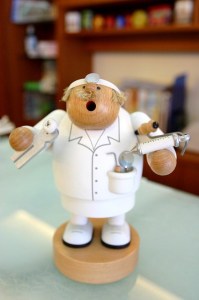Is tooth extraction necessary for braces? Many patients looking into lingual braces are curious about whether tooth extraction will be necessary. The answer to this question depends on your unique teeth and your goals in orthodontic work. Dr. Adam Schulhof is an expert in orthodontic work and can help you to make the right decision.
 When Is Tooth Extraction Necessary?
When Is Tooth Extraction Necessary?
In general, it is easier to perform orthodontic work when no tooth extraction is needed. However, there are a few occasions when removing one or more teeth may be necessary in order to achieve your appearance goals and get the healthy smile you desire. These instances include:
Overcrowded teeth:
- Overcrowded teeth: In some cases, people simply have too many teeth for the size of their dental arch, jaw, and face. Dental arches made slightly larger, but there is a limit. If your bone structure, facial features, and the size of your teeth will not allow a straight and perfect smile, you may need to remove teeth in order to achieve your goals.
Severe overbite or underbite:
- Severe overbite or underbite: When some of your teeth protrude, moving them into position may be very difficult. Removing some teeth to allow more room for repositioning or aligning teeth may be the only way to ensure an aesthetically pleasing result.
Bite mismatch or other asymmetries:
- Bite mismatch or other asymmetries: In many cases, orthodontic problems are more than merely cosmetic. The jaw may not align properly or otherwise, may not accommodate a full set of teeth in an attractive fashion. In these cases, removing one or a few teeth may allow you orthodontist more room to work with, to give you the attractive and perfectly aligned result you desire.
Dental issues such as impactions:
- Dental issues such as impactions: There are times when a few teeth themselves are not in good enough condition to be aligned using any kind of orthodontic work. These teeth are usually so diseased that they are living on borrowed time, even if they may not yet appear so. Removing these teeth before orthodontic work will prevent a lot of pain and the need for ongoing treatment.
Some more reasons for tooth extraction include:
- The jaw is not large enough to accommodate all your teeth.
- A tooth is misshapen or disproportionally large or small compared to other teeth
- A tooth has become decayed or otherwise damaged due to overlap or malocclusion
- Straightening all the teeth without removing some will create instability in the long run
If you have questions or concerns about whether tooth removal is needed before you can get braces, it is important to discuss this with your orthodontist. An orthodontic professional will help you to make a treatment plan that best fits your goals and your current health.
What Happens in a Tooth Extraction?
- Many people are afraid of dental procedures. However, having healthy and balanced teeth is necessary to having successful orthodontic work. Is this procedure safe? Does tooth extraction hurt? Understanding more about having teeth extracted, including what to expect from the procedure and from tooth extraction aftercare, often makes the process less scary. Before you have the procedure, you will be given local anesthetic, also called painkiller. In addition, many people are given general anesthesia so they will be asleep during the procedure. In most cases, the answer to the question, “does tooth extraction hurt?” is a reassuring no.
- The oral surgeon will then remove the tooth, leaving a dental socket that they will pack with sterile gauze. Some people may also have a few small stitches in the area. Tooth extraction aftercare is usually straightforward. Most people will take painkillers prescribed by their doctor. In addition, ice can help. Because of soreness in the mouth, many people will need to eat soft or cold foods for a few days. You also will want to avoid activities that include sucking or spitting, such as drinking from a straw, as these can dislodge the clot in the socket and cause a painful condition called dry socket.
People Also Ask
- How long do you have to wait to get braces after tooth extraction?
- Is tooth extraction necessary for braces?
- Which tooth will be extracted for braces?
- Are teeth removed for braces?
Methods to Avoid Tooth Extraction
Damon System Might Work
- One of the more popular options these days for orthodontic treatments is called the Damon System. This particular method has been proven to offer patients optimal teeth straightening results without the need to have any teeth removed prior to the installation of the braces. This system may be applied to the teeth using clear or metal hardware. The patient is also able to choose different colors of bands to create a more unique look and style. This is a simple and powerful system to help give the best results with minimal treatment time and discomfort.
There’s More to Come…
Invisalign System
- The Invisalign system for aligners offers patients a completely different alternative to traditional braces with no need to use any clear or metal hardware. This system uses hardware that is similar to retainers or mouth guards to gently move your teeth into place. The benefits of this system is that it is easy to use and easier to keep your teeth clean compared to traditional braces. These are able to be used on patients in their teens and for adults. The only time when this is not a viable option is when a patient has unsalvageable tooth damage or severe stages of tooth decay. Invisalign generally reduces the need for a tooth removal because it works by gently expanding a patient’s jaw. This can create room for the teeth that are overcrowded and eliminate any need for extractions.
Tooth Slimming
- Tooth slimming is another orthodontic technique that can help to minimize or avoid the need for extracting teeth. Sometimes, the reason why teeth are crowded in the mouth has to do with jaw size, and sometimes it has more to do with tooth size. In the cases where teeth width is contributing to overcrowding, it is often possible to slim down the responsible teeth by shaving minimal portions from each side. This can give all teeth more room to grow in comfortably without having to extract any teeth.
- What is most important to understand about this is that tooth slimming typically occurs over time anyway as the patient ages. Just the process of chewing, brushing, flossing and other activities will cause the type of tooth friction that can aid in slimming. But sometimes natural slimming is still not enough or there isn’t an option to wait until it happens naturally and still achieve orthodontic treatment results. In these cases, manual tooth slimming is a good second choice to avoid tooth extraction.
A Palate Expander
- For younger patients (aged 16 or younger), a palate expander can often provide a smooth path to avoid tooth extraction. The palate expander works to widen the palate before it hardens into place (which commonly happens around age 16). This makes room for teeth to grow in without as much risk of overcrowding.
Finding the Right Orthodontist
Ultimately, it is crucial to listen to your orthodontist when deciding what procedures should be part of your orthodontic care. A trained professional is an essential part of making the right decision. This is why it is so important to find the orthodontist who is perfect for you. Most people find that the right orthodontist has the following qualities:
- Experienced with the types of braces you are interested in getting
- Trustworthy and knowledgeable
- Trained in how orthodontia can affect facial aesthetics
- Commitment to learning new techniques and practices
- A willingness to treat each patient as an individual, with a personalized treatment plan
Is It Time to Get the Smile of Your Dreams?
Many adults have teeth that they are not happy about. Some of us did not get the orthodontic work we needed as children and adolescents; others had work done but our teeth gradually drifted back to an unattractive shape. In addition to cosmetic issues, misaligned teeth can cause a wide range of health issues, including increased cavities, difficulty eating, jaw pain, and even migraines.
There are many options that do not have visible wires and brackets, such as lingual braces and the invisible aligners mentioned above. These options can help adults to get the high-quality orthodontic work they need without having the visible mouth full of metal that we associate with braces. They are just as effective as traditional braces and often are very affordable. An experienced orthodontist can help you decide what kind of orthodontic work is best for your needs.
If you are unhappy with your smile, the next step is to schedule a consultation with an orthodontist. Talking to an orthodontist can help you make an educated decision. At your consultation, your orthodontist will examine your teeth, take x-rays, and otherwise evaluate your bite and your jaw structure. They will make recommendations that will help you to achieve the alignment you need for attractive aesthetics and future dental health.
Call an Expert Today
Calling Dr. Adam Schulhof‘s office today for a no-commitment consultation is the next step to getting the smile you have always desired. Dr. Schulhof is an expert in lingual braces and other invisible orthodontic technologies. Our friendly office staff are happy to help you make an appointment today.
Like what you read? Comment below or CLICK on an APP LOGO on the screen to follow us and join in the conversation
New Jersey Office
400 Kinderkamack Rd.
Oradell, NJ 07649
Phone: 551-231-5323
I Want Braces (Is Tooth Extraction Really Necessary?)




